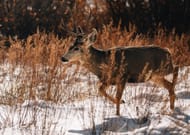A mule deer with CWD (chronic wasting disease) was found in Yellowstone National Park (YNP), and the park's authority confirmed this via a press release. This is the first time this fatal disease has been detected in Yellowstone National Park. The adult mule deer was found in the park’s southeastern area, near the Yellowstone Lake.
The deer was captured by the Wyoming Game and Fish Department (WGFD) for a biological study near Cody in March. He was fitted with a GPS collar, which notified his death in mid-October. The sample collected for testing gave positive results for this disease at the WGFD’s Wildlife Health Laboratory.
What is CWD (Chronic wasting disease)?
Chronic wasting disease (CWD) is a disease that affects deer, elk, reindeer, sika deer, and moose. It is caused by prions, which are a type of small pathogenic agent that is nothing but a type of malformed protein. These prions are deposited in the animal’s brains and tissues. This disease is contagious and has no cure yet.
CWD can affect animals of all ages, and symptoms might or might not be observed in all cases. Affected animals might even die without showing any symptoms. In the press release, the YNP authority requested visitors notify them in case they see any sick or dead animals at the park. The park authority also said that it is going to revise its 2021 CWD Surveillance Plan.
What is CWD in deer?

According to the Centers for Disease Control and Prevention, symptoms may vary in each infected case and common signs of chronic wasting disease may include:
- drastic weight loss (muscle wasting)
- stumbling
- lack of coordination
- listlessness
- drooling
- excessive thirst
- excessive urination
- drooping ears
- lack of fear of humans
Due to the complexity of the symptoms, it is often difficult to diagnose this disease in its early stages, and is only known when the condition is severe or the animal dies. Chronic wasting disease is not known to affect domesticated animals or cattle.
Can humans get CWD from deer?
Chronic wasting disease belongs to a family of diseases called prion diseases or transmissible spongiform encephalopathies (TSEs). This disease is not known to affect human beings and cannot be transmitted to humans from the affected animal. However, some animal studies suggest that this disease might pose a threat to some human-like primates.
The transmission of this disease from animal to animal generally takes place via body fluids. It can also spread from the fluids of dead, infected animals. Prevention of contamination is the only way to reduce the impact on the animal population.
Indranil Biswas is a nutritionist and personal trainer with a diploma in dietetics and personal training with a specialization in sports nutrition and strength training.
What do you think of this story? Tell us in the comments section below.
